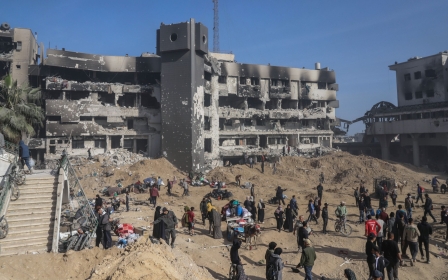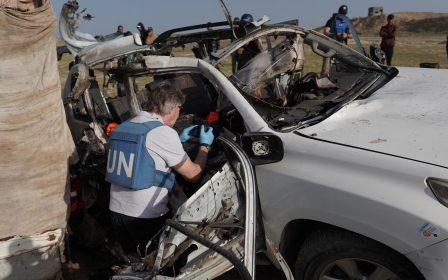War on Gaza: The Palestinian doctors found dead in the ruins of al-Shifa hospital

The bodies of two of Gaza’s most respected doctors, a mother and son, have been found among the dead after the Israeli army’s withdrawal from al-Shifa hospital, following its two-week siege of the medical complex.
Ahmad al-Maqadmeh, a Palestinian plastic surgeon in his early thirties, and his mother Yusra al-Maqadmeh, a general practitioner, were found dead alongside their cousin Bassem al-Maqadmeh at the roundabout next to the Carrefour Mall in Gaza City, a short walk from al-Shifa.
Both doctors were working at al-Shifa when the Israeli siege of Gaza’s largest medical complex began. They had lost contact with their family six or seven days ago and it is thought that they were executed by Israeli forces as they were trying to escape the hospital. Their bodies were found riddled with bullets.
Ghassan Abu-Sittah, a British Palestinian plastic and reconstructive surgeon who had been working with Ahmad at al-Shifa and al-Ahli hospitals in Gaza, told Middle East Eye that Ahmad was a “brilliant young plastic surgeon” and that his mother was “highly respected and very well known in Gaza”.
Ahmad is survived by his wife and two young children, who are both under five, and by his father. The family are believed to still be in Khan Younis, in the south of the Gaza Strip.
At the beginning of the war, Ahmad and Yusra, who are both from Gaza, stayed in the north of the Strip to work while their families went to Khan Younis.
'He was such a kind, enthusiastic soul. He was always calm. He was always composed'
- Ghassan Abu-Sittah, surgeon
Abu-Sittah said that in the early months of the war, when it was still possible to travel between the two, Ahmad would go and visit his wife and two children for a week and then return to work at either al-Shifa or al-Ahli Hospital, which is in northern Gaza.
“He was such a kind, enthusiastic soul,” Abu-Sittah, who also worked with Ahmad during the March of Return in 2021, said of his friend and colleague, whom he helped train. “Whenever he had some free time, he would come and track me down at al-Ahli because he wanted to learn.”
Abu-Sittah said that after he returned to Britain, following a 43-day spell working in Gaza during the war, Ahmad would send him photos of wounds and information about cases he was working on. “He was always calm,” the British Palestinian doctor said of his colleague. “He was always composed. I never saw him lose his rag.”
A former winner of the Royal College of Surgeons of England’s Humanitarian Innovation Fellowship for his work on gunshot wounds in Gaza, Ahmad was, Abu-Sittah said, “very academically minded and ambitious – he wanted to come to the UK to learn more”.
“We are deeply saddened to hear of the death of surgeon Dr Ahmed al-Maqadma," Tim Mitchell, president of the Royal College of Surgeons of England said in a statement.
“Our thoughts are with his family and dedicated medical colleagues caring for those injured during conflict, and trying to maintain services, under such terrible circumstances.
“The Royal College of Surgeons of England supports the World Health Organisation’s call for the protection of health facilities, health workers, patients and civilians in accordance with international humanitarian law.”
Total devastation
The Israeli army withdrew from al-Shifa hospital on Monday, having blown up or otherwise destroyed much of the complex, which accounts for 30 percent of Gaza’s medical capacity.
Israeli military officials said that its forces had killed 200 people and arrested 900 during the 15-day assault on the hospital. Gaza’s civil defence said that around 300 people had been killed.
The army said it conducted its raid without harming civilians and medical personnel. Medical organisations and eyewitnesses strongly rejected that claim, with the deaths of Ahmad and Yusra al-Maqadmeh backing up these rejections.
The World Health Organisation said at least 21 patients died during the siege. Survivors told Middle East Eye that scores of civilians were killed during the fortnight-long siege.
“People were shot at and attacked. We are civilians. The scene was worse than an earthquake,” one young man said.
“There were no doctors. Some of them were killed, some of them got arrested. Those who survived, survived. Those who died, died. Fifteen days of siege in al-Shifa with nothing, no food, no water.”
Israeli claims
“There was no reason to torch the hospital and blow it up as they were leaving,” said Abu-Sittah, who believes that the Israeli army’s destruction of al-Shifa Hospital is part of its plan to wipe out Gaza’s healthcare system and render the coastal enclave uninhabitable even after a ceasefire.
The British-Palestinian surgeon said that this destruction had also been made possible by western journalists who had perpetuated and given credence to Israeli claims that al-Shifa was sitting on top of a Hamas command and control centre.
“Hamas terrorists operate inside and under Shifa hospital and other hospitals in Gaza,” Daniel Hagari, Israel's chief military spokesman, told a news conference on 27 October.
Last week, Hagari said that those arrested at al-Shifa were “very important Hamas officials”. Israel has yet to provide any evidence to back those claims. Hagari said Israel was not revealing the identities of those arrested “because they hold significant intelligence”.
“Where are these underground tunnels? We didn’t see any of them,” Abu-Sittah, who worked at al-Shifa for many of the 43 days he spent in Gaza during the war, told MEE.
“Not even the hospital guards had guns, they had batons. Do you think patients would have stayed if there had been Hamas gunmen running around?”
Over 340 health workers have been killed in Israel’s assault on Gaza. Outside al-Shifa, some of the dead bodies had begun to decompose. Inside, there was nothing but devastation.
Middle East Eye propose une couverture et une analyse indépendantes et incomparables du Moyen-Orient, de l’Afrique du Nord et d’autres régions du monde. Pour en savoir plus sur la reprise de ce contenu et les frais qui s’appliquent, veuillez remplir ce formulaire [en anglais]. Pour en savoir plus sur MEE, cliquez ici [en anglais].





